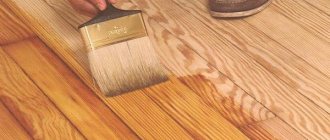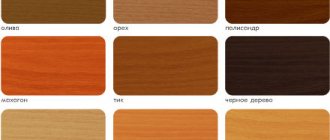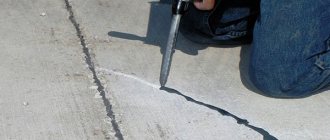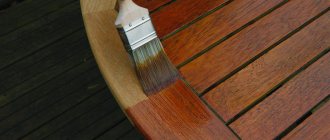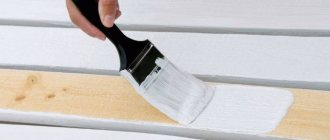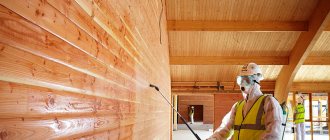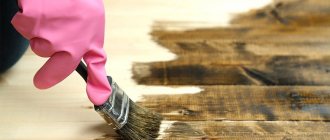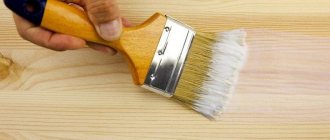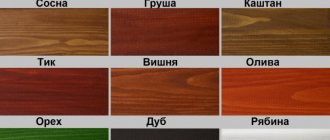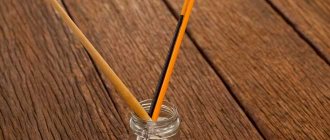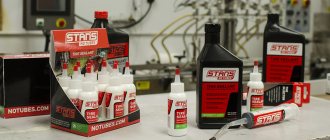People build a house from the material that is available in abundance at hand. In Russia, in most of its territories, this is a tree, so since ancient times, houses have been built from logs.
Today, wooden construction is also quite widespread. Light summer houses in summer cottages, bathhouses, and outbuildings are built from logs or timber. Capital private houses for permanent residence are also sometimes made of wood; The fashion for wooden construction has been revived.
Indeed, wood has many advantages as a building material:
- A wooden building is environmentally friendly. A special microclimate that is favorable for humans is created inside it, of course, only if the house is built in compliance with all the rules, reliably insulated and protected from dampness, and environmentally friendly materials were used when decorating the premises. In this case, the house will have optimal air humidity; it will be warm in winter and cool in summer.
- A wooden house in Russia is the most inexpensive construction option. Wood usually costs less than brick or aerated concrete. A massive foundation is not required, since a wooden house is lightweight. One-story houses and bathhouses are often placed on a columnar, non-buried foundation; for a house of 2–3 floors, in most cases a strip foundation is poured. These options require significantly less labor and materials than, for example, a slab foundation.
- The construction of a wooden house is quite quick and relatively simple. Usually they buy a finished log house, bring it to the construction site in disassembled form and assemble it.
- A wooden house evokes pleasant associations. If it is made with high quality and accuracy, it looks very attractive. Now it is possible to seal joints with sealants, which are selected by color. This way, you can achieve an aesthetically pleasing appearance for your home, unlike caulked houses that may have untidy clumps of tow hanging from the walls.
- Baths are traditionally made of logs and timber, since only in a wooden bath can you get “that same” atmosphere.
Features of wooden buildings
Wooden buildings have their own distinctive features, which are associated both with the characteristics of the tree itself and with the design features.
According to its characteristics, wood is very different from other building materials.
This material is porous and has a fibrous structure. It is capable of absorbing moisture and then drying out, and these processes are accompanied by a change in its linear dimensions, as well as the appearance of cracks and crevices in the logs themselves.
The structure of a wooden building has places where logs or beams come into contact with each other, which are called inter-crown joints. Since the linear dimensions of the logs (beams) change with fluctuations in temperature and air humidity, cracks can form here, allowing cold air and dampness to pass into the building. In addition, in the absence of sealing, condensation will accumulate here, leading to the growth of microorganisms, mold, and also to the destruction (rotting) of the wood.
The casing of windows and doors, even if they are made exactly to size, may subsequently not fit tightly, and cracks will appear under them, which will become cold bridges.
Separately, it is necessary to mention wooden baths, since they have their own characteristics:
- changes in humidity;
- temperature changes;
- tile or concrete floors in the washroom.
When to seal windows
Installation of plastic windows has a number of features and requires strict adherence to technology. If you violate the installation rules, the tightness of the products will be incomplete, which will greatly affect the quality and service life. Most often, windows are installed in the warm season, when it is almost impossible to detect blowing and freezing. But when cold weather sets in, all problems quickly become apparent.
Insulating windows yourself using sealant
The main signs that it is time to seal your windows are:
- condensation appears on the glass,
- moisture accumulates on the windowsill,
- there is mold in the corners, near the slopes,
- when checking with your hand, a draft is felt,
- the temperature in the room decreases.
If the window is installed correctly, the technology is followed, then it does not blow out, as a result the room becomes maximally protected from external factors. Loosely sealed seams allow water and cold air to pass through, so immediately after a problem appears, you need to use window sealant.
Where in a wooden house sealing may be required
So, in a wooden house, seals and seals require inter-crown joints, gaps around the perimeter of casings of windows and doors, junctions around heating and water pipes, chimneys, fastening baseboards, places where communications pass, and various seams.
In addition, there may be defects, cracks, or crevices in the structure and in the logs themselves that need to be repaired. In addition to defects, special cuts are also made on logs to compensate for deformations, and these cuts also need to be filled with some kind of elastic material.
In a bathhouse on a tiled or concrete floor, a waterproof sealant is required in the seams between the tiles, as well as in the places where the floor meets the walls and the drain, and the walls in the corners.
How to prevent a gap from forming
It is important to avoid excessive distance at the point of contact of the hygienic device; large gaps are quite difficult to deal with, which cannot be said about insignificant, small gaps.
To level the distance, you can resort to several techniques used by professional installers. Before installing a bathtub, craftsmen often suggest that the homeowner create an additional niche that covers an uneven section of the wall and hides the edge of the container.
A false wall can also help to avoid an overly large seam in this specific place, because a gap width of 10 cm is simply unacceptable.
Specialized corners can hide the gap, but cannot completely protect against moisture leakage onto the floor; only sealant provides high safety.
The process of adjusting the height of the legs should not be done carelessly; such design elements often helped to level the gap for the better.
Traditional method of sealing seams between logs
Since wooden buildings have been erected for many centuries, there are traditional solutions for sealing the seams of the log house and insulating the house. Our ancestors, faced with the problem of how to seal the seams between logs, chose from available natural materials. Tow and moss were used.
Today, these materials are also used due to the fact that they are inexpensive and can even be free if you collect moss yourself in the forest. Materials such as flax wool and jute are also used.
Filling the inter-crown joints is called caulking.
The essence of caulking is that fibrous materials are placed in the crown joints, and then they are driven tightly using special spatulas.
The process of caulking at home is quite labor-intensive and requires physical strength and certain skills. The treatment is carried out by moving along the entire perimeter of the house, outside and inside, first to the height of the first log, then subsequent ones in order, so that the house does not warp.
The first caulking is done during the construction of a house. Then it is required after 1–2 years and every 3–5 years due to the fact that the insulating materials cake, sag, and the tightness is broken.
After caulking, the house increases in height by 10–15 cm, which means that the gaps above the door and window frames increase and the interior decoration deteriorates. Therefore, if this option may still be acceptable for a bathhouse, then for a permanent house with interior decoration it is absolutely not.
User opinions
| Sealant | Review |
| Auster Parquet | Overall I'm pleased with the result. For a reasonable price, the result is a high-quality product that dries well, is flexible, economical in consumption, and easy to paint. The downside is that the color does not exactly match what is indicated on the package, and with large gaps additional sealing is required (for example, with a cord), otherwise the sealant will fail. |
| Neomid Wood Professional | This composition would be much better suited for walls. And the floor quickly cracks, despite the fact that the room is not so accessible. Otherwise, it’s a good sealant, it applies smoothly, and paints very well. |
| Wepost Wood | The only downside is the decent price. Otherwise, only positive impressions. The room has become much warmer, the floor does not creak, the seams do not crack, although they have been treated with sealant for quite some time. And what is important, any annoying small insects have practically stopped appearing. |
Requirements for sealant for sealing joints in a wooden house
Today, builders have at their disposal various types of sealants - paste-like materials that easily take any shape and reliably seal seams, joints and junctions.
Using sealant, you can very reliably and accurately fill all seams and cracks and ensure complete tightness.
The “warm seam” technology is also used, which allows you to insulate a wooden house so that heating costs are reduced by 30–40%. It will be discussed below.
Sealant for a wooden house or bathhouse is used for both external and internal work. Therefore, it must meet certain requirements:
- have high adhesion to a porous material, which is wood;
- be durable, elastic, waterproof;
- be resistant to sunlight and temperature changes;
- do not support the growth of microorganisms, mold, fungus;
- ensure durable and reliable sealing of seams and joints throughout the entire service life;
- be safe for indoor use and do not emit toxic fumes;
- be easy to use and do not require the use of special equipment;
- to ensure aesthetic characteristics, have a choice of shades or allow the seams to be painted.
Recommendations for foaming
- Foaming is carried out with smooth, uniform movements from bottom to top or from left to right.
- The gap is not filled completely, but by 30-50%.
- The foam is supplied in small strips, the length of which should not exceed 100 mm.
- The holes are foamed in several layers, each subsequent layer is applied after the previous one has hardened.
- The through holes on one side are covered with sheets of some material, cardboard is suitable, and after hardening they are removed.
- When carrying out work in the cold season, the foam container must be kept in warm water at a temperature of 30-40 degrees.
- The efficient pushing of material out of the container is facilitated by placing the container upside down.
- The optimal temperature for operation is +5…+25 degrees.
What sealants are suitable for sealing seams between logs
Modern sealants are classified according to the type of active component into acrylic, silicone, bitumen, rubber, thiokol, and polyurethane.
Not just any sealant is suitable for a wooden house.
Silicone, acrylic and polyurethane sealants are considered suitable for sealing seams in a wooden house. Each of them has its pros and cons.
Silicone sealant
Silicone sealants are made on the basis of organosilicon compounds. They are acidic and neutral. Acidic silicone sealants are not recommended for interior use.
The advantages of this type of sealant include high elasticity (stretching up to 250%), durability and retention of elasticity in a wide temperature range from –60° C to +300° C, water resistance, high adhesion to different types of building materials, and resistance to vibration.
However, silicone sealant does not work very well in compression, and the seams of wooden structures can not only stretch, but also shrink. As a result, when the seam is compressed, bubbles may appear on the sealant.
Important!
Silicone sealant is not compatible with paints and varnishes, so you will have to select it by color.
Acrylic sealant
Acrylic sealants are very popular for woodworking.
They are considered environmentally friendly and suitable for interior work. Acrylic sealants are elastic, vapor permeable, show high adhesion to wood, and are available in a wide palette of shades. They are resistant to solar radiation and have antiseptic properties. They can be diluted with water.
Acrylic caulk can be a good choice of environmentally friendly material for sealing cracks when doing interior work in a room that is not constantly exposed to high humidity (i.e., not a bathhouse).
But it is not suitable for outdoor work, as well as for use in baths, because it cannot withstand constant exposure to high humidity and is unstable to sudden temperature changes.
Polyurethane sealants
These are universal sealants based on hybrid polymers. The essence of how such a sealant works is that in a closed package it is inert, but upon contact with atmospheric moisture it begins to polymerize.
Cemmix recommends two types of polyurethane sealants for woodwork - Facade Adhesive Sealant and Seam Adhesive Sealant.
Preparation for repair
Regardless of what material is used to seal cracks, it will only hold if preparatory procedures are carried out, namely:
- Removing dirt from crevices - you need to take a stiff brush with long bristles and walk along the crevice several times. This will help remove the damaged layer of wood, dust, dirt and bacteria that are present there. A vacuum cleaner, which is convenient for handling even the smallest cracks, will help remove fine dust.
- Disinfection - it is important that bacteria do not grow in the crevice, which will subsequently cause rotting of the wood. For this purpose, the floor at the site where the material is applied is treated with any antiseptic. Chlorhexidine and copper sulfate have proven themselves well. After treatment, you need to allow several hours to dry completely.
- Expanding the gap - if, when removing dirt, the wood begins to crumble, it is necessary to remove the entire loose layer until strong and durable fibers appear. Otherwise, the material will not have the necessary adhesion to the wood, and cracks will appear again.
During work, it is recommended to ensure that the floor has a minimum load and maximum evenness of the surface being treated. All heavy furnishings should be removed from the room during the renovation.
Expert opinion
Levin Dmitry Konstantinovich
If the cracks are large and holes are formed during their processing, the option of replacing individual boards with new ones is considered. Worn wood not only fails to perform its basic functions, but is also difficult to repair.
Adhesive sealant for seams, gray
CEMMIX Adhesive-sealant for seams is a one-component polyurethane sealant for sealing various seams, junctions of steps and walls, entry of pipes and ventilation systems and rigid-elastic gluing of various materials.
More details
These are one-component, ready-to-use sealants that allow you to seal seams up to 20 mm wide. They are suitable for both external and internal use, safe for people and the environment.
Facade adhesive-sealant and adhesive-sealant for seams demonstrate the following characteristics:
- high adhesion to any building materials, including porous ones, without the use of primers;
- elasticity, the ability to restore its original shape after deformation;
- strength, resistance to mechanical damage;
- service life of 10 years with preservation of all characteristics;
- water resistance, including in conditions of constant humidity;
- lack of support for mold and mildew growth;
- resistance to solar radiation and temperature changes;
- chemical inertness;
- ease of use (do not require complex equipment, allow you to adjust the seam, do not bubble or spread during application);
- thixotropy;
- possibility of application even at sub-zero temperatures;
- fast initial curing.
There is a choice of shades: Cemmix facade adhesive-sealant is available in eight colors, and Cemmix joint adhesive-sealant is available in four. Also, a seam made with sealant can be painted.
Important!
Polyurethane sealants are also suitable for sealing joints between tile and concrete floors in washing areas of bathhouses.
Warm seam technology
The use of this technology for sealing crown joints makes it possible to insulate a wooden house so much that the air temperature inside rises by 10°C or more, thus saving on heating costs for years. Therefore, although sealing the seams in this case will cost more than caulking, in the future the savings will begin very soon. Considering that the seams will last from 10 to 25 years, unlike caulking, which must be renewed at least once every 5 years, and also that the sealing process itself is simpler and cleaner, it’s not worth even talking about how much more profitable it is to use sealant for seams in a wooden house.
Sealing of seams begins a year after construction, when the house shrinks. Inside, the seams are sealed after one heating season.
Video: “Warm seam.” Application technology
The “warm seam” technology involves laying a cord made of foamed polyethylene at the mouths of the seams. The thickness of the cord is chosen depending on the width of the slots, up to 10–12 mm or more.
The cord is secured with a stapler or hammered with a chisel. After this, Cemmix facade adhesive-sealant or Cemmix adhesive-sealant for seams is applied.
A brief summary of what composition to use to seal the gap between the bathtub and the partition
As has already become clear from the information above, it is quite difficult to do without a preliminary assessment of the condition of the materials being joined. Only after inspecting the wall and bathroom will you be able to make the right choice and purchase the appropriate type of sealant.
To help beginners, specific recommendations from professional installers will be presented regarding all common cases. Before caulking or gluing a joint, you should learn the step-by-step algorithm of actions, and also not deviate from generally accepted norms.
The wall is tiled
First of all, it is necessary to start from the type of bathroom; to level the gap between the partition and the product made of acrylic, plastic or fiberglass, it is enough to purchase a silicone-acrylic, as well as an MS-polymer model of a specialized solution.
When faced with an enameled metal container, you should choose an acidic silicone compound or a polymer one.
Vessels made from marble or artificial stone will require a special approach and care; the seams are often lubricated at a distance of up to 1 cm with MS-polymer compounds; if the gap is larger, then they rely exclusively on a polyurethane base.
Porcelain and earthenware bathtubs are very popular, despite their high cost; to work with them, you need silicone or polyurethane sealant.
The wall is painted
Such cases are no exception; you definitely shouldn’t worry or panic; you can find a way out, taking into account advice from experts.
Experienced craftsmen recommend using only silicone and acrylic models for sealing walls with a plastic bathtub on such surfaces.
Enameled container samples with a gap of more than 5 mm are coated with latex sealant, marble products are connected to the partition using an MS-polymer or polyurethane solution.
Porcelain vessels and painted parts can also be connected to each other; an acidic silicone composition is best suited for such manipulations.
Features of sealing inter-crown seams with polyurethane sealant
Cemmix facade adhesive-sealant and Cemmix adhesive-sealant for seams are modern materials that allow you to get a professional result, even if you do not have many years of experience in such work behind you. When applying sealant, the seam can be adjusted, you can even partially remove it and redo it.
By the time they start sealing the crown joints, usually impregnation or paint has already been applied to the wood. You should check the adhesion of the sealant to such a surface in a small area; if it is insufficient, the seams are cleaned and dusted.
Installing a cord at the mouth of the seam not only insulates it, but also serves to eliminate the third contact surface. This is a prerequisite for the seam to be strong.
The sealant is applied using a construction gun. If you have experience, you can apply it immediately, with a slow movement in one direction. If you are not confident in your abilities, you can protect adjacent surfaces with masking tape.
Important!
The thickness of the seam should be such as to cover at least 4 mm on each side of the joint. The width of the seam should be twice its depth.
To seal the sealant, use a spatula moistened with soapy water. You can also correct the seam with a rag soaked in soapy water, but this must be done before the seam initially hardens, within 15 minutes.
After this, the seam must be protected from mechanical damage during the entire polymerization time (assuming that the polymerization rate is 1–2 mm per day).
Also, polyurethane sealants are used to fill and seal all other joints and abutments, gaps around casings (in these places you can compromise on accuracy, since they will be covered with platbands), cuts on logs, and any cracks and crevices in the wood.
Application technology
As for the method of use, it is very simple and known to everyone who has worked with sealants at least once and knows their features. For this, a special gun is used (mechanical, pneumatic, electric, etc.).
The sealant must be squeezed out evenly, making sure that the seam is not too thin and not too thick. To fill a gap, you need to place the nozzle of the nozzle into its cavity and then squeeze out the sealant, running along the entire length of the hole.
You need to work with these compounds without delay, since polymerization of some of them occurs quite quickly. It is not recommended to straighten the seam with your hands, since the sealant will stick to the skin and can be quite difficult to remove.
Adhesive sealant for seams, gray
CEMMIX Adhesive-sealant for seams is a one-component polyurethane sealant for sealing various seams, junctions of steps and walls, entry of pipes and ventilation systems and rigid-elastic gluing of various materials.
More details
As a result, a rubber-like waterproof membrane is formed in the seams, which is elastic and resistant to various adverse influences and reliably protects the house from dampness and cold. A pleasant bonus will be the appearance of the house - neat, stylish and interesting. The color of the sealant is usually selected to match the wood (impregnation), but it is also possible to choose a contrasting option.
Video: Instructions for installing sealant
Cemmix facade adhesive-sealant and Cemmix adhesive-sealant for seams are the optimal choice for sealing and sealing any seams, abutments and joints in a wooden house or bathhouse. By using them, you will get reliable and durable sealing of seams, a beautiful appearance of your home, and savings on heating costs. You can buy Cemmix facade adhesive-sealant and Cemmix adhesive-sealant for seams wholesale, retail and online.
You can buy CEMMIX products without leaving your home, with discounts from 5 to 33%!!!!
Buy on Ozon
Buy on Yandex.Market
Buy on Wildberries
Buy at Leroy Merlin
Or you can find the nearest official dealer in your region on our map
← Sealant for external use
Roof sealant →
Return to list
Comments
What it is?
As the name implies, the main purpose of the entire group of similar building materials is to create an airtight coating. Sealants can be completely simple, without any additional properties, or special, for example, resistant to temperature influences, containing bacterial protection against fungus, etc.
According to the method of preparation, sealing compounds are divided into:
- One-component (hardens in air when applied to the surface);
- Two-component (they are two separate compositions in different packages, which begin to harden only some time after mixing).
The main active ingredient in sealants is acrylic, silicone, thiokol or urethane. For interior work and for wooden floors in particular, the first two types are usually used.
Requirements for the sealing compound:
- Good adhesion (adhesion) of the sealant to the surfaces to which it is applied;
- Elasticity, because even after applying the sealant, the slight mobility of the wooden elements relative to each other does not disappear;
- No harmful emissions during operation;
- The possibility of applying a final paint coating over it or the presence of persistent color pigments in the sealant itself;
- Water resistance. Of course, the wooden floor, and with it the sealant, will not be exposed to prolonged and abundant exposure to water, but the sealing compound must tolerate changes in humidity, cleaning with a wet rag or accidentally spilled water, otherwise it will be of little use.
News
We are always ready to help
Cemmix has opened a free hotline
to help you with any questions related to construction using concrete additives. Call and ask, our consultants are always ready to help!
Hyperplasticizer
Hyperplasticizers are a new type of plasticizing additives for concrete, ensuring the mobility of the mixture above P5. In addition to plasticity, they increase the water resistance and frost resistance of concrete by 2-3 times.
Sealing the joints of the bathtub with the wall with a border (plinth) made of plastic or tiles
Finishing joints with plastic borders is a common solution if the gap width exceeds 2-3 cm. To attach PVC skirting boards, acrylic adhesives are most often used to ensure rigidity and water resistance. At the same time, the plastic itself, due to its elasticity, compensates for small movements of the bathtub.
Ceramic borders are more aesthetically pleasing and suitable for finishing rooms with designer interiors. In addition to ceramics, natural stone - granite or marble - can be used for these purposes. Moisture-resistant acrylic or polyurethane glue is suitable for gluing.
Combination of different methods
Experts in the field of finishing work believe that no matter how effective each of the methods of sealing the joint between the bathtub and the wall is considered, the most reliable is still a combination of two or more of these methods.
And the most common combination is applying sealant over dried polyurethane foam. First, the master pours the foam (as described above), waits for it to dry, and then cuts off the excess. And then a layer of silicone (or acrylic) sealant is applied.
The result is a smooth joint with an ultra-strong level of protection from water. And if you also stick a border tape on top, the level of reliability and durability of the sealed seal will triple! And the bathroom itself will look complete in terms of design, neatly decorated.
( 50 votes, average: 4.70 out of 5)
